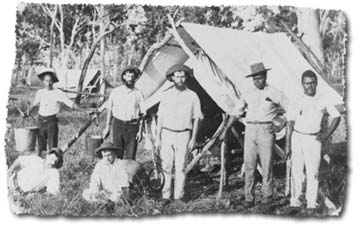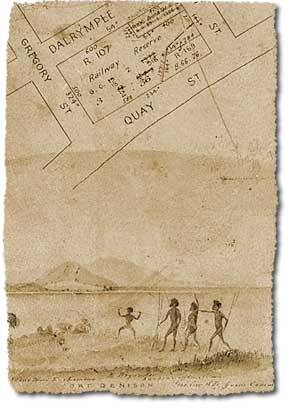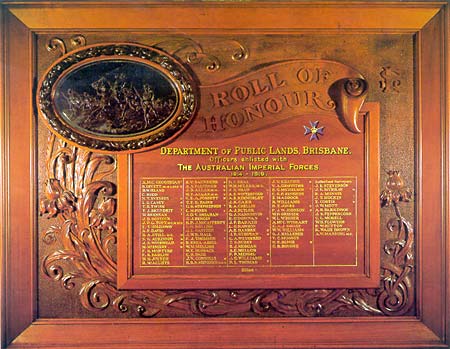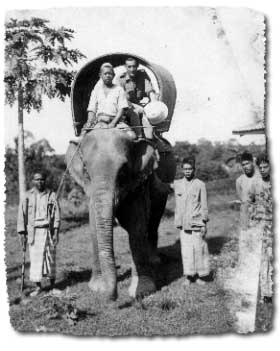Surveyors at work
Surveyors and the Aboriginal people
Valuable assistants
Robert Dixon, Granville Stapylton and James Warner were the first surveyors to arrive in Moreton Bay in 1839. With a shortage of suitable workers, they were allocated convicts to act as their chainmen. Many of these convicts were found to be ‘insolent, sulky and stupid’, as Warner reported in 1840. (Warner, J 1840, Biographical file, Museum of Lands, Mapping and Surveying)
Dixon, Stapylton and Warner soon began to use local Aboriginal men to look after the horses and oxen. They also helped to carry out general survey work including clearing lines and dragging the chain.
In difficult country, the expertise of the Aboriginal people was essential for the survey to be successful.

Augustus Poeppel surveyed the Queensland – South Australian border in 1881. He was well served by local aboriginal people who showed him how to find the native wells in the Simpson Desert. The Assistant Surveyor, LA Wells, described finding one of these native wells:
‘Prior to Mr Poeppel’s arrival, I had found out from “Dickery” natives that there was a native well (“Mickerie”) called “Yalkerie”, named after a bulb which grows in profusion in the flats between the sandhills. The native women root these up when dry and roast and eat them. We got an old native to show where the well was and found the locality was only fifteen minutes north-east of the Corner (Poeppels), and it would be a boon to us if the supply was good. The hole was about twelve feet across the top and at the bottom only two or three feet. It was, when cleared out, about fifteen feet deep. The water, although sweet, was good and apparently a good supply, but it was necessary to sink another well, and fix up a windlass before we could make use of the supply.’ (Wells, LA 1881, Wells Reminiscences, Museum of Lands Mapping and Surveying)
Frontier conflict
Many of the early colonial surveyors worked in small groups, often in isolated locations. This resulted in a certain amount of frontier conflict between survey parties and the Aboriginal people. Even though raiding the surveyors' camp became a frequent event in the 1800s, only a handful of fatalities occurred. Overall, surveyors tried to avoid conflict as Surveyor McCabe of Gladstone did in 1854:
‘...When out on duty one day, fully armed, they espied some blacks, hunting.[sic] Panic-struck at the sight of the ...., the surveyor fled, followed by his party, who threw away their carbines in order to make the best use of their legs, and arrived in camp without any serious injury, beyond a broken shin or two in falling over logs.’
‘The natives, not having the slightest hostile intention, brought the firearms into the settlement next day, and delivered them over to Mr Wilmott, the storekeeper, remarking with much laughter, how frightened the white fellows were and how they did run. Having discovered the weakness of the surveyor's party (about a score strong), the blacks in a few days came down in force, and proceeded to plunder the tent. The gallant surveyor with his party at once retired behind a big tree, where twenty stand of arms were piled, and with a Colt's revolving rifle in his hand, observed with the greatest complacency the plunder of his tent, remarking that he was paid to measure and not to fight.’ [sic] (McCabe, Moreton Bay Courier, 26 August 1854, p. 1.)

Field book and plan sketches
As a directive from Sir Thomas Mitchell, Queensland's early surveyors would generally record in their field books the Aboriginal and Torres Strait Islander place names and occasionally their meanings. Some would draw the local Aboriginal people which would often appear on the face of the survey plan.
Surveyors and draftsmen and war
In 1914 many Queensland surveyors and draftsmen volunteered for service at the front. Their skills in surveying and mapping were used to survey the trenches and record the location of their own and enemy trenches at Anzac cove and many other locations.
On 2 May 1917, a magnificent memorial was publicly unveiled. It was dedicated to the Queensland Lands Department officers and a number of authorised surveyors who enlisted in the Australian Imperial Forces during the First World War.
The memorial is constructed of Queensland silky oak and has been carved to complement the gold lettering which sits on a red bean centrepiece.
The memorial is now classified in the World Heritage listings and is mounted in the old Lands Administration Building (now the Conrad Treasury Hotel) in George Street, Brisbane.

Surveyors working overseas
In the 1900s, Queensland surveyors were very much sought after to work in British colonies that had inhospitable climates such as Malaya, New Guinea and parts of Africa.


Advertisements were placed in Brisbane papers and letters sent to the Queensland Surveyor-General in a bid to recruit these men. The feeling was that Queensland's surveyors were well trained and were used to the rigours of tropical climates. The retiring Surveyor-General Archibald McDowall, in a speech to The Queensland Institute of Surveyors in 1902, said:
‘He knew that our Queensland surveyors were appreciated, in proof of which he would mention the application that had come to Queensland from West Africa. It was a far cry from Lagos, on the Gold Coast to Queensland, but it had come and he took it as more than a mere compliment. It was a distinct recognition of the quality of our Queensland survey work.’ (Queensland Institute of Surveyors 1902-3, Transactions and Proceedings, vol. 2 p. 13.)
After World War I, the demand from around the world for Queensland surveyors continued as they had become renowned worldwide in their profession. They were employed in many different countries either to do survey work or to teach surveying skills.
Related links
- Learn about Queensland’s historical surveying processes.
- View images of instruments and equipment used to survey and map Queensland.